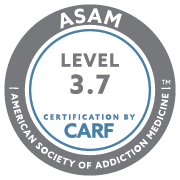
Psychodrama is a type of group therapy that we utilize in our curriculum at New Directions for Women. This type of therapy uses guided drama, or what is known as role play, to explore certain issues that one may have experienced in their lifetime. It is an experiential field of psychology that has been shown to help increase physical and mental well-being. At New Directions for Women, we use psychodrama as a form of therapy to help women in their recovery journey.
Where Did Psychodrama Come From?
Psychodrama was originally created by Jacob L. Moreno, MD, and has since been further developed. “Jacob Levy Moreno, the man who developed psychodrama, also coined the phrases “group therapy” and “group psychotherapy.” At its core, psychodrama uses deep action methods to explore and correct issues that have been identified in the group.”
Through sociometry, experiential methods, group dynamics and role theory, this type of treatment allows for personal growth. Patients who engage in this type of therapy begin to experience a greater insight into the self, and learn to integrate affective, cognitive and behavioral issues. This therapy helps patients gain a better understanding of the issues they are facing. By participating in psychodrama, a patient can gain greater physical and emotional well-being and enhance cognitive function. As such, many women at New Directions for Women who have used psychodrama in their recovery process go on to continue their emotional development as they learn to process any trauma or abuse that they may have experienced.
The Elements of Good Psychodrama
There are five operational components or elements in psychodrama. The first is the protagonist. This is the person who represents the theme. Then, there are the auxiliary egos, which are members of the group who will take on the role of people who have been significant in the protagonist’s issue. Then, there is the audience. The audience represents the wider community and society as a whole. The next element is the stage itself, which can be anything from a simple room to a full set. Finally, there is the director. The facilitator is a trained psychodramatist and their role is to ensure participants are appropriately guided through the entire process. At New Directions for Women Gina Tabrizy acts as our psychodrama facilitator with patients in treatment at our facility. Gina helps women at New Directions obtain a concrete understanding of trauma and the effects that it has on addiction. Through her usage of psychodrama therapy she is able to give a comprehensive therapeutic approach to patients who have trauma and struggle with the disease of addiction. Gina Tabrizy had the following to say about Psychodrama, “Psychodrama is a powerful tool that helps to bypass the cognitive process by allowing patients to get in touch with the depth of their emotions about significant life events. Psychodrama can provide a patient with a cathartic insight into the etiology of their distorted beliefs and shame, which allows them to begin the healing process.” Gina is a certified Psychodrama Director, a licensed Marriage, Family, and Child Counselor (MFC), and the owner and Clinical Director of Harmony Heals.
Besides these five elements, there are also three phases that psychodrama goes through. Firstly, there is the warm up. “The group theme is identified and a protagonist is selected.”
After warm up, the group goes through the action phase, where they dramatize the problem that the protagonist is facing. Through the action phase, they are enabled to find new ways of resolving certain problems. The final phase is sharing. During this period, all members of the group get together and discuss how they connected to the action phase and how this will help them further.
Action Methods
Someone like Gina Tabrizy who is trained in psychodrama understands the various action methods that can be used in order to see the greatest benefits from this type of therapy. “Action methods involve physical, cognitive and emotional movement of the client rather than sitting and talking, as in more conventional therapy.”
Through these methods, women in treatment at New Directions for Women are able to process the trauma that they may have experienced in their life. Participation in psychodrama enables them to find better ways of coping with certain difficulties and situations they encounter which includes chemical dependency and domestic violence. Psychodrama is often described as eye-opening. This therapy allows participants to see how different perspectives can lead to different responses, and teaches them how to incorporate these responses in their own lives.
New Directions for Women is a chemical dependency treatment facility located in Orange County California that offers help to women of all ages, pregnant women in any trimester, and women with children. Founded in 1977, our courageous and visionary founders asked for the help of Newport Beach Junior League members to fulfill their vision of a tranquil home-like facility that would treat women with dignity and respect. Our caring admissions counselors are available 24/7 to take your call and answer any questions you may have on getting help. Reach us by phone at 800-93-WOMEN. We can help. Stay in the loop with New Directions for Women by connecting with us on Twitter, Facebook, or LinkedIn.












